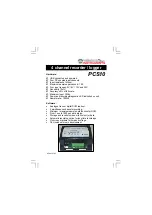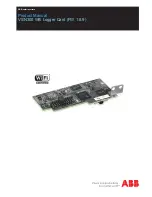
l
Not enough differential terminals are available. Differential measurements use twice as
many
analog
ue
input
terminals
as
do
single-ended
measurements.
l
Rapid sampling is required. Single-ended measurement time is about half that of
differential measurement time.
l
Sensor is not designed for differential measurements. Some Campbell Scientific sensors are
not designed for differential measurement, but the drawbacks of a single-ended
measurement are usually mitigated by large programmed excitation and/or sensor output
voltages.
Sensors
with
a
high
signal-to-noise
ratio,
such
as
a
relative-humidity
sensor
with
a
full-scale
output
of
0
to
1000
mV,
can
normally
be
measured
as
single-ended
without
a
significant
reduction
in
accuracy
or
precision.
Sensors
with
a
low
signal-to-noise
ratio,
such
as
thermocouples,
should
normally
be
measured
differentially.
However,
if
the
measurement
to
be
made
does
not
require
high
accuracy
or
precision,
such
as
thermocouples
measuring
brush-fire
temperatures,
which
can
exceed
2500
°C,
a
single-ended
measurement
may
be
appropriate.
If
sensors
require
differential
measurement,
but
adequate
input
terminals
are
not
available,
an
analog
ue
multiplexer
should
be
acquired
to
expand
differential
input
capacity.
Because
a
single-ended
measurement
is
referenced
to
datalogger
ground,
any
difference
in
ground
potential
between
the
sensor
and
the
datalogger
will
result
in
an
error
in
the
measurement.
For
more
information
on
grounds,
see
and
49).
6.1.3.2
Minimizing
ground
potential
differences
Low-level,
single-ended
voltage
measurements
(<200
mV)
are
sensitive
to
ground
potential
fluctuation
due
to
changing
return
currents
from
5V,12V,
SW12,
and
C
terminals.
The
datalogger
grounding
scheme
is
designed
to
minimize
these
fluctuations
by
separating
signal
grounds
(
)
from
power
grounds
(G).
For
more
information
on
datalogger
grounds,
see
10).
To
take
advantage
of
this
design,
observe
the
following
rules:
l
Connect grounds associated with 5V,12V, SW12, and C terminals to G terminals.
l
Connect excitation grounds to the nearest
terminal on the same terminal block.
l
Connect the low side of single-ended sensors to the nearest
terminal on the same
terminal block.
l
Connect shield wires to the
terminal nearest the terminals to which the sensor signal
wires are connected.
If offset problems occur because of shield or ground wires with large current flow, tying the
problem wires into terminals next to terminals configured for excitation and pulse-count should
6. Measurements
49
Содержание CR1000X
Страница 1: ...Revision 02 21 2019 Copyright 2000 2019 Campbell Scientific ...
Страница 2: ......
Страница 4: ......
Страница 6: ......
Страница 8: ......
Страница 16: ...Appendix A Glossary 176 Appendix B Index 214 Table of Contents viii ...
Страница 20: ...l Smart sensors o SDI 12 o RS 232 o Modbus o DNP3 o TCP IP o RS 485 1 Data acquisition system components 4 ...
Страница 192: ......
Страница 237: ...wiring panel 5 Appendix B Index 220 ...
















































